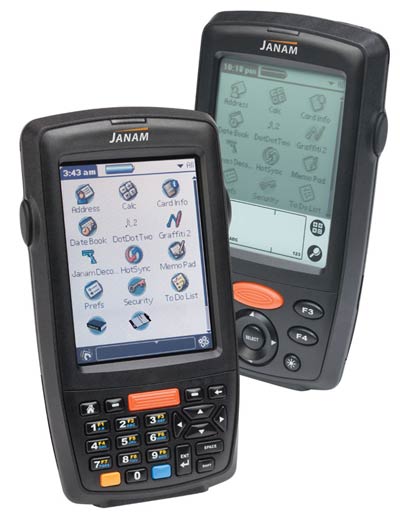Janam is a New York-based rugged mobile computing vendor with worldwide distribution. The company was established in January of 2006 as a provider of purpose-built rugged handheld computing devices for mobile workers. The term "purpose-built" includes providing niche products such as a couple of rather unique Palm OS-based handhelds specifically designed for companies that heavily invested in Palm OS data collection devices and are not ready to abandon that once indomitable platform.

From today's vantage point where iPhones and Android devices rule and sell by the tens of millions, it's easy to forget that before there were modern era smartphones there was Palm. And Palm once commanded more marketshare than either the iOS or Android ever managed to achieve. Palm successfully prevailed—in the consumer markets at least—against its sole serious competition, Windows CE. For many years, it seemed inconceivable that Palm should ever lose its dominant position. Yet lose it they did, and spectacularly so.
In its day, the Palm OS was so good that there was a (self-described) Palm Economy, and many companies practically built their business around Palms and Palm-based applications. And even though Palm handhelds haven't been available for years, Palm apps continue to be used, and there's a demand for ruggedized Palm OS-based handhelds. And that's exactly what Janam offers with their XP20 and XP30 handhelds.
The XP20 and XP30 Series are rugged handhelds with either the classic Palm 160 x 160 pixel monochrome display format (XP20), or the later 240 x 320 pixel Palm color display format (XP30). Each model can be ordered either with a classic backlit PDA keypad (just function keys, nav pad and scanner button) or with a backlit numeric keypad for more rapid data entry.
On the technical level, the XP20 and XP30 both use a 266MHz Freescale i.MX21 processor that's much faster and much more powerful than any of the processors used in early Palms. Performance should definitely not be an issue here.
In terms of size, the XP20 and 30 measure 3.1 x 5.75 x 1.3 inches and weigh about ten ounces, which is pretty much the size and weight conventional PDAs and Pocket PCs used to be. It's certainly pocketable, and considering the ruggedness of the platform and the fact that it also includes an industrial quality 1D/2D CMOS imager, that's a nice package.
As data capture devices, the aforementioned integrated Adaptus 752 x 480 pixel CMOS imager can read and decode a large variety of 1D and 2D codes and symbologies. There is a user-accessible micro-SDHC card slot for extra storage (something that no old Palm device ever had). For wireless communication there is 802.11b, Bluetooth 2.0 and— now here's a flash from the past—IrDA.
In the ruggedness and durability department, the XP20/30 can handle respectable four-foot drops onto concrete, carry IP54 sealing, and can handle a wide operating temperature range from 14 to 122 degrees Fahrenheit. The 7.4 watt-hours Li-Ion battery should be good for full-shift operation.
With the XP20 and XP30, Janam offers a platform with very narrow and very targeted appeal. The heydays of Palm devices is a decade in the past, and that's a long time. Still, if someone loves the Palm OS and needs a dozen or a hundred or a thousand to replace disintegrating original Palm hardware, look no farther. Pricing seems to be in the US$750-900 range, depending on model and configuration.






